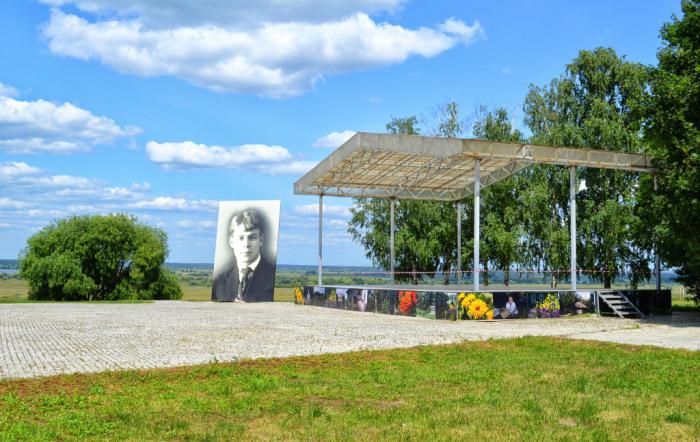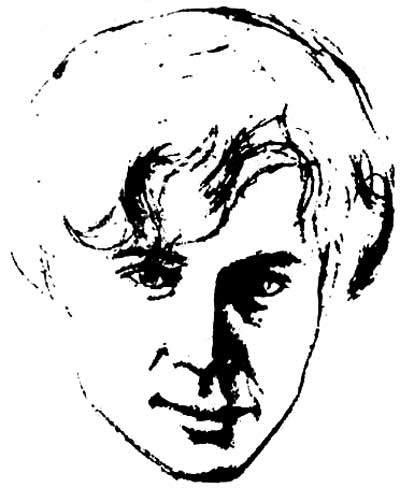Russian literature is rich in talented nuggets. Through years and space, they speak to us from the pages of their works. And inquiringly strict, benevolently wise, they look from reproductions of pictorial portraits and documentary photographs.
Life story - a story of fate
Each portrait of Yesenin is a reflection of some moment of his life, a fragment of a bright creative biography. Peering into the poet’s face, catching a fleeting movement of the lips, trying to understand the
expression of the eyes, we partake in the great destiny of a man who reflected the contradictions and aspirations of his complex, contradictory and tragic era. Quite a lot of intravital images of Sergey Alexandrovich, made over 10 years - from 1915 to 1925, have come down to us. This gap contained a lot of things: creative ups and downs, poetic searches and moments of crisis eclipses, desperate hopes and a chasm of disappointment. Therefore, if we consider this or that portrait of Yesenin separately from others, it will not be possible to comprehend the depth of his personality.
The art of knowledge

The many-sided, many-sided soul of our national poet manifests itself as childishly defenseless and gentle, sometimes tearfully and tremulously, like a naked nerve or an tensioned string, then hopelessly and gloomyly, then detached from the outside world and directed inside itself. So, any portrait of Yesenin is not just a reflection of his appearance at a certain point in time. If we look at them one by one, in accordance with the years of creation, we can trace the spiritual evolution of the poet, the history of growing up and the degeneration of a gifted village youth into a genius mature singer of village Russia. And another interesting detail: while reading the poems of the poet, we mentally draw for ourselves its appearance: exuberant gold of hair - like the foliage of autumn maple; piercing blue eyes - like the lakes of his beloved Homeland. And every photographic and author's portrait of Yesenin known to us is a wonderful addition to our own perception, a unique opportunity to better know and feel his soul.
Yesenin in 1915

The first surviving image of Sergei Alexandrovich dates back to 1915. Almost a century separates us from that time. This is a portrait of Sergei Yesenin, made by a friend of the poet, lawyer Vladimir Junger. What is a good image created by an unprofessional artist? The striking external similarity of the original with the work. This was undoubtedly recognized by everyone, as they personally knew the young poetry, who had just arrived in the capital, and who saw the drawing. Indeed, the Junger portrait of Sergei Yesenin, made with a colored pencil on a cardboard sheet, conveys the most characteristic details of the look: famous ringlets, youthful gullible look, sad bend of lips. Shyness, inexperience, naivety of a country boy who fell into the literary world of the capital, just beginning to partake of the first temptations of fame and recognition, are visible in the portrait. However, the other character traits of the poet were subtly noted and reflected by Junger. This is an inquiring mind, and inconsistency, and nervous tension. Thus, in a hastily made sketch, dashed lines outline the main directions of the personality of the great poet.
On the pages of textbooks
Yesenin enters our life from early childhood - from the first school years. Together with him we listen to how the winter sings and sounds, lulling the old dense forest with a mournful blizzard song. Together we admire the green-headed birch - a shy beauty. And with special curiosity, young readers consider the portrait of Yesenin. It is very important for children to know what this amazing person looks like, who called the month a foal, maple by the window - a good friend, who saw and felt a living soul in every blade of grass. After all, reading one poem of the poet’s poem, we ourselves, not noticing it, begin to look at the world through his eyes, notice the inconspicuous, quiet beauty of nature, which we forget about with age.
Therefore, a portrait of Yesenin for children usually consists of photographs of 1922. It is they who accurately convey the great personal charm of the poet, the friendly, kind attitude to all living things.
Photograph Tour
By the way, photos of the poet can also tell us what Yesenin was like. And if the portraits are still quite subjective, because there are always 2 personalities here - the model and the artist himself, then in the photo we see only the person who was shot. What will Yesenin's portrait portraits tell us about?
One of them, dated 1912, presents to our attention a seventeen-year-old Seryozha with his sisters. The photo is interesting in that it really reflects those warm, tender feelings that the future poet always had for his sisters. Esenin's biographers repeatedly cited the facts of how he helped Catherine and Alexandra financially, the sisters often and for a long time visited him, coming from Konstantinovo.
In the photograph of 1913, we see another Yesenin. The photo shows a young man, dressed solidly: in a hat and coat, with a jacket and tie. The youthful appearance is gentle, touching, but the look is serious and dreamy, with a slight, slightly noticeable squint. In the photo of 1914, Sergey tries on a bohemian image: a hairstyle according to the artistic fashion of those years, a blouse with a bow. But the face is simple, rustic. The poet’s hand is noteworthy - a thin brush with graceful fingers.
Benchmarking analysis
An interesting work is to compare 2 images: a photograph and a portrait of Yesenin. The photo presented above was taken in 1916, when the poet was drafted to the front during the First World War. It is he who we will compare with the pencil portrait of the artist Naumov (presented below).
Both images have common details: military tunic, insignia. And the impression is also kindred: a completely youthful face (it seems that Yesenin does not mature over the years, childhood is traced in him constantly), the refinement of nature.
The military uniform, as a rule, gives young people a more rude, courageous appearance. But not to Sergey. On the contrary, the tunic only emphasizes softness, tenderness, some even femininity. And defenselessness! And it is worth paying attention to the poet's eyes. And in the photo, and especially in the figure, they seem to emit soft, kind light, thoughtfulness and warmth. But this is exactly what we love the poet!
Yesenin and Gorodetsky
Portrait of Yesenin, a pencil made by Naumov, is not the last in a series of similar works. Original, full of frank sympathy and evoking a warm smile from the audience, the drawing by Sergey Gorodetsky cannot but attract our attention. Moreover, he was executed, as they say, from nature, rather it is even a household sketch than a portrait in the full sense of the word. The title of the work is corresponding: “Yesenin in the Dunkin’s scarf”. What kind of dunk? Isadora Duncan! As explained by Gorodetsky, Sergei Alexandrovich fell ill, Duncan came to his apartment very alarmed. And since Yesenina was in a fever, the rooms were not too warm, she threw her scarf on Sergey. The latter looked both miserable and comical, but in general so touching that Gorodetsky grabbed onto pencils and paper. As you can see, real geniuses are not afraid to look funny!
Excursion to Socionics
"Portrait" is a term not only from painting and literature, that is, associated with art. It is used, for example, both in psychology and in socionics, when it is necessary to classify or describe a sociotype. So what kind of person was Yesenin? Oddly enough, he had a female portrait of a person. What this means can be expressed in several sentences. He is a lyricist, romantic, introvert. It perceives the world not by itself, but through the prism of emotions and those images, sensations, experiences that cause events in it from the outside.

Yesenin thought not stereotypedly, but creatively, non-standardly, he was charming and attracted people to himself. If you peer into many photographs of Sergei Alexandrovich of the 20s, then they can clearly see "bohemianism." And in most of the pictures and portraits of different years, we clearly catch a certain sadness that shows how dissatisfied the poet was with his life and reality, how perplexed and restless he felt. However, some photos give us an idea about the other side of the personality of Sergei Alexandrovich: sincere love in life, in the world.
In love with life
Another of the most illustrative in this sense, photo portraits dated 1925. On it Yesenin with his sister Catherine. They walk along Prechistenka, in the hands of the poet an accordion, the cap is riveted to the back of his head. The poet smiles - wide, open, happy, carefree. In general, Yesenin’s smile is a rather rare phenomenon, which is not very captured. And therefore this photo is so expensive.
There is another photo of the same year (presented below). Yesenin is depicted in a half-turn. Her hair was combed back, "under the policy" - that was the name of this hairstyle. Open high forehead, soft facial features, kind serious expression.
Before us is not the golden-haired youth with whom we first met, but a man who has experienced and understood a lot. Eyes look directly at us - attentively, thoughtfully, sadly and wisely.
Here he is - the beloved poet Sergei Yesenin.